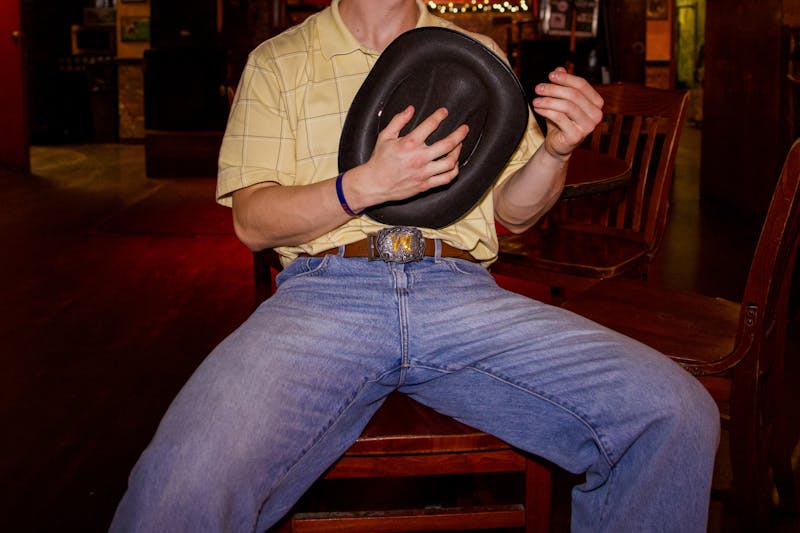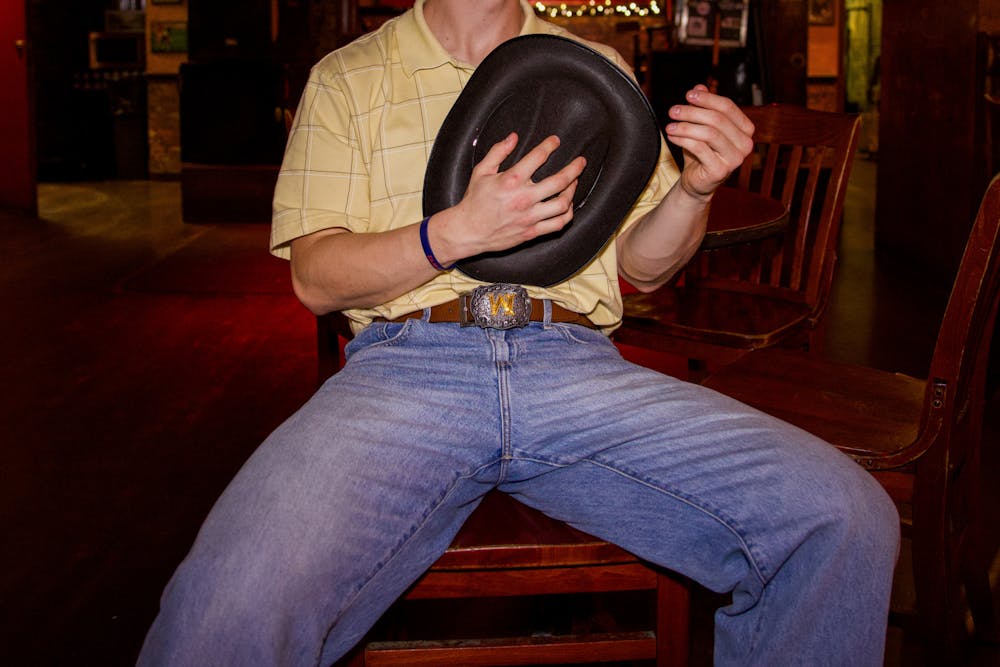Columnist Simar Soni examines the resurgence of the Americana aesthetic and its political significance.
Credit: Weining Ding
One chilly September morning in 2022, a Kim Kardashian post appeared on my feed. Against the sweeping American flag, she sported a denim-on-denim outfit and shiny bleach blonde hair. Her makeup was minimal and her butt bare on display, free in true American fashion. I knew, at 16 years old, that Donald Trump would become president once again.
This memory resurfaced at the student-run fashion magazine, the Walk’s annual charity show on April 25. Students gathered to watch models grace the runway in gingham prints and boots. As I flipped through the pages of this season’s magazine, I came across the Americana shoot — one of the shoots I styled. I remember enthusiastically saving ’60s cut-creases and Coke cans on my mood board. These images were astonishingly nostalgic, reminding me of summers in my small hometown, when I’d roll my eyes at my friends blasting country music in their Jeep. Despite being a child of immigrants who would have lacked equal rights in the 1950s, there was something so comforting about this image of Midwestern America. Looking back, I have to ask how someone like me, who always dreamt of living in a big city, could find such solace in this romanticized “American” image?
Across the world, people laugh at what they perceive America to be: a collage of guns, burgers, and cowboys. On the other hand, America has driven global culture for decades. Hollywood guides international film. New York is the epicenter of finance. Los Angeles is the mecca for social media stars. Streetwear and hip-hop, originating in American cities, are now common all over the world.
Unsurprisingly, however, “Americanness” has been rejected by the domestic urban masses. For instance, when many of us go abroad, we do not identify with America. While others are from France, India, and Japan, we are from California, Texas, or New York. My Canadian cousins introduce me as their “cousin from the States,” not the United States. We make this distinction because both Americans and non-Americans know that America is not unified as a single homogeneous nation. Rather, America is a country made up of many people and cultures.
In recent years, Americana has replaced many of these regional subcultures. Today, it is “cool” to be American. Kim Kardashian’s attempt at embodying Marilyn Monroe’s Hollywood glamour trended on social media for months. Wealthy northern students adorn $400 Ralph Lauren American Flag Sweaters. Cowboy boots have become a staple of influencer culture. According to Inside Radio, country music is one of the fastest-growing genres, with 20 billion streams in 2023. With the rise of stars like Chappell Roan and the revival of Ethel Cain in pop culture, it is clear that America is so back.
This rise in American aesthetics is not new. There has been a 54% increase in country music listening since 2005, and in 2015, 70% of non-white Americans listened to country music once a week. These demographic shifts are largely explained by the 2008 recession and 9/11. In times of crisis, we seek stability. There is something beautiful about sitting in a diner with your only worry being what milkshake to order. Our clothes are a reflection of our deepest desires. When we wear our faded “Red, White, and Blue,” we are really chasing the promise of the American dream.
Even if Americana’s revival is a coping mechanism, it has been paired with ultra-conservative politics, specifically with Trump’s re-election. Some may argue that this conservative shift is a response to millennials and older Gen Z’s “ultra-liberal” ideology. Is this conservative trend part of the process of finding political equilibrium? I disagree.
Gen Z was projected to be the most progressive generation. UCLA found that a majority of informed Gen Z planned to vote for Democratic candidate Kamala Harris in the 2024 election. The shift between political progressiveness and aesthetic conservatism was far too swift. The conservative tide turned back too fast to be part of the regular pendulum of “isms.”
We, as Americans, can and have reclaimed Americana. Formerly incarcerated Dean Gillispie’s Americana miniatures were highlighted at The Museum of Modern Art, symbolizing his time in prison and his process with re-entry. Lana Del Rey represents modern teenage girlhood through 1950s visuals in her music videos. She often collaborates with men of color, like ASAP Rocky, who were historically excluded from these art styles. To be clear, there is nothing wrong with loving fringe or cowboy hats, especially when you are subverting them in unique and contemporary ways.
However, today’s version of Americana is far from a coping strategy or an artistic subversion. Rather, it is a symptom of a greater conservative cultural revolution. In a world where speaking against the Trump administration can ruin your life and lead to loss of your visa or degree, it makes sense why students would align themselves with American ideals. In an America that is politically divisive in every possible way, dreams of a united “America” overtake the culture, serving as a recession indicator. Today, Americana is paired with harmful rhetoric hell-bent on creating an out-group. The already mystified “American Dream” is becoming more and more exclusive. Americana continues to signal the reactionary political landscape we are entering. So go wear those cowboy boots that pop up on Instagram, but be wary of the messaging behind them. At Penn, where freshmen (including myself) wear silk and turtlenecks on nights out — where we glorify good ol’ American money — it’s easy for us to fall victim to Americana, first as an aesthetic but soon enough as an ideology. And when Americana is the dominant doctrine, our politics become based on a fabricated notion of American hegemony and exceptionalism. We start to reject our enemies, allies, and even fellow citizens when they do not fit the vision of what an “American” should be.
SIMAR SONI is a College first year studying political science from Danbury, Conn. Her email is simars@sas.upenn.edu.
The Daily Pennsylvanian is an independent, student-run newspaper. Please consider making a donation to support the coverage that shapes the University. Your generosity ensures a future of strong journalism at Penn.

